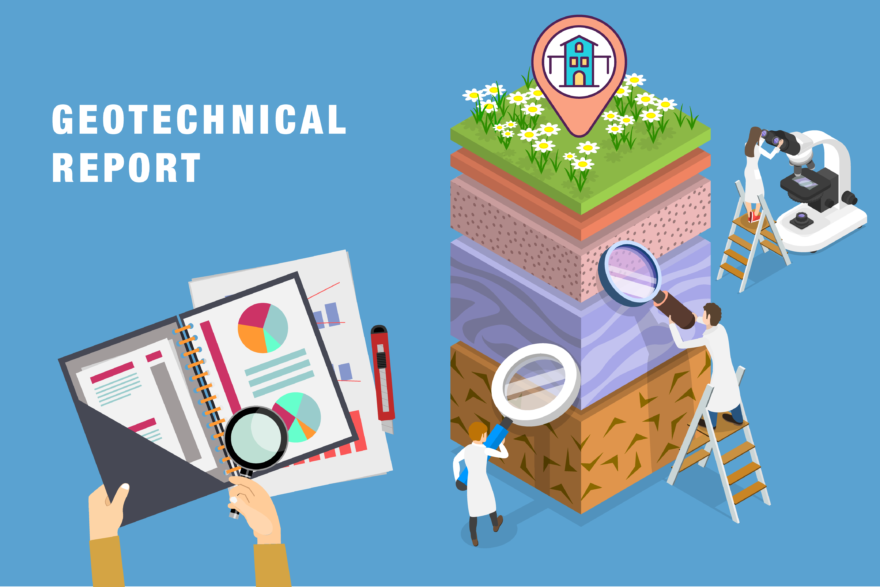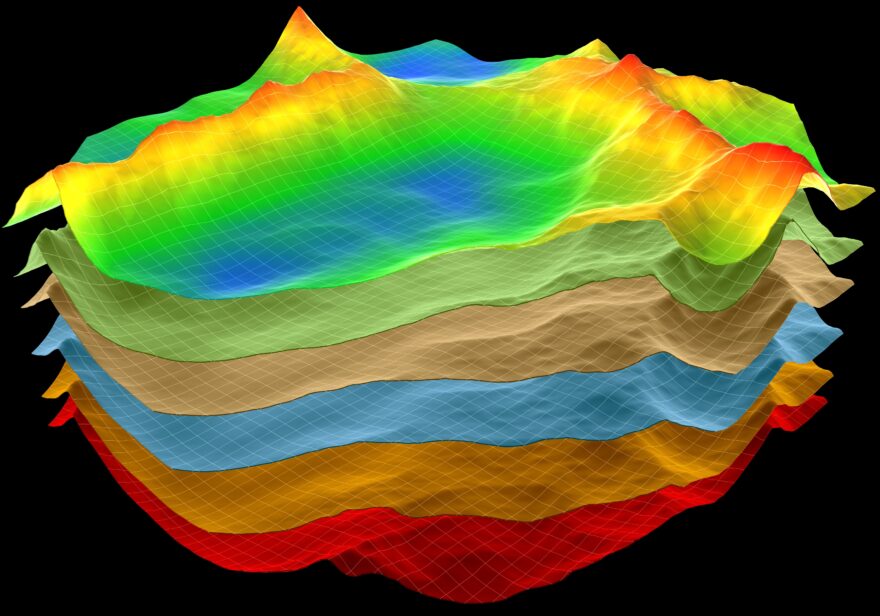A geotechnical report is a technical document, generally written for a particular development or project about a specific site, by a geotechnical engineer or engineering geologist.
The report summarises key information about the ground conditions across a proposed development area, and commonly includes design advice and recommendations relating to those conditions. The geotechnical report typically presents factual and/or interpreted information which serves as a basis for the civil and structural design of a development. In particular, it should highlight any potentially problematic conditions, so these are addressed early in the design of the proposed structure or otherwise anticipated for mitigation during the construction.
Types of geotechnical investigation reports
Geotechnical reports are specific to each site, project and client and therefore have different objectives depending on the stakeholder (e.g., due diligence land purchase, landowners, contractors, engineers, regulatory authorities).
Douglas Partners’ engineers and geologists closely follow Australian Standards such as ‘AS 1726 – Geotechnical Site Investigations’. Dependent on the project stage and objectives, there are at least three report types that a geotechnical engineer may produce.
1. General report
Presents information obtained from the site investigations. The report content might include:
- factual information and observations;
- interpretations; and
- opinions.

2. Geotechnical data (factual) report
This documents the procedures used, and data collected (field measurements, boreholes/trial pit logs).
The report should contain:
- objectives and agreed scope;
- location and description of the site and its history;
- plan demonstrating investigation locations;
- description of the regional and local geology;
- records of field work, including method and results; and
- laboratory testing and summary of results.

3. Geotechnical interpretative report
An interpretative report would generally include:
- reference to the data on which interpretation is being made;
- interpretation of the site geology and the development of the geotechnical model;
- a summary of the geotechnical properties of the ground relevant to the project;
- interpretation of the implications of the ground conditions for the project;
- assessment of potential risks to the project; and
- recommendations for further work, if needed.

While a geotechnical report relies on factual evidence to create a thorough understanding of the ground conditions, the data would be from a finite set of sampling/investigation points. There will always be opportunities to improve the understanding of a site by increasing this amount of sampling.
Developing a ground model for an interpretative report requires the factual data to be assembled into a geometrically coherent form, which then enables the ground conditions to be inferred at site locations not specifically investigated. The reliability of the inferred ground conditions depends strongly upon the amount and scope of the site investigation field work and testing, and also upon the knowledge and experience of the Geotechnical professional.
Development and refinement of the ground model is often a progressive process built on a range of broad local experience, preliminary desktop study together with site-specific data from the field work. Improvements to the ground model can be made as these activities are progressed and more information become available.
From the perspective of project stakeholders
Project stakeholders (owners, architects, design engineers, contractors, and regulatory authorities), would each have differing interests and responsibilities on a project. It is important that each of these groups are able to understand and accurately interpret the geotechnical report as it might apply to their needs. The geotechnical report might contain critical information that can impact project timeline, budget and potential for failure or otherwise costly issues. Therefore, geotechnical reports should be written with the client’s needs clearly in mind.
Often the stakeholder perspectives would be:
Owner: keen to understand if soil conditions are suitable for the intended construction and the associated costs of footings, excavation, retention, and ongoing maintenance if required.
Architect: an architect is concerned about the building’s esthetics and its form in the environment, therefore the geotechnical report will assist them with design, and inform the appropriateness of building layout and design.
Contractor: concerned with the possible impact of the ground conditions on buildability, site formation earthworks, equipment selection, and construction sequence. Contractors also seek geotechnical reports to assist with their design and construct project and for independent assessment of completed earthworks.
Structural engineer: needs to gain an understanding of the ground conditions, particularly in relation to the expected performance of the foundation support. They will want information on likely constraints or opportunities, and advice on suitable ground design parameters which are appropriate/applicable to their structural design tasks.
Authorities: will use to verify the suitability of the design submitted for building consent. Required to assess the design against statutory guidelines and industry benchmarks for good practice.

Important to remember!
The geotechnical investigation report is a snapshot of the conditions encountered at the time of the investigation and for the purposes for which the investigation was intended.
While subsurface conditions are not expected to vary much over time, changes can sometimes occur, depending on climate and other external influences. Therefore, the relevance and applicability of the geotechnical report may be diminished if the development scope changed. For example, geotechnical data gathered for the initial proposal of a three storey structure would likely be insufficient for a high rise building with a multi-level basement, and probably be unsuitable for a tunnel.
Further advice or clarification of the report information should be sought (by the appropriate stakeholder) if the proposed development is changed significantly or if unexpected conditions are encountered. Often this would be needed during detailed design and prior to the substantial commencement of construction.
It is important that all parties involved understand the ground conditions as described in the report so the geotechnical risks are correctly managed, so as to avoid adverse outcomes that could potentially affect the project cost, program and personnel safety.
